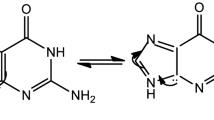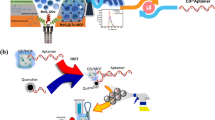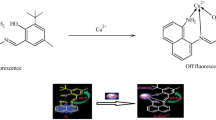Abstract
Zinc(II) and copper(II) complexes containing Schiff base, 2- methoxy-6((E)-(phenylimino) methyl) phenol ligand (HL) were synthesized and characterized by elemental analysis, IR, NMR, and single crystal X-ray diffraction technique. The fluorescence properties and quantum yield of zinc complex were studied. Our data showed that Zn complex could bind to DNA grooves with Kb = 104 M−1. Moreover, Zn complex could successfully be used in staining of DNA following agarose gel electrophoresis. MTT assay showed that Zn complex was not cytotoxic in MCF-7 cell line. Here, we introduce a newly synthesized fluorescence probe that can be used for single and double stranded DNA detection in both solution and agarose gels.














Similar content being viewed by others
References
Coles S, Hursthouse M, Kelly D, Toner A, Walker N (1998) Halide titanium (IV) Schiff base complexes; fluoride and bromide derivatives and evidence for a new seven-coordinate chloride intermediate. J Chem Soc Dalton Trans :3489–3494
Mohammadi K, Niad M, Jafari T (2014) New 3, 4-diaminobenzoic acid Schiff base compounds and their complexes: synthesis, characterization and thermodynamics. Spectrochim Acta Part A 122:179–185
Ji Y-F, Wang R, Ding S, Du C-F, Liu Z-L (2012) Synthesis, crystal structures and fluorescence studies of three new Zn (II) complexes with multidentate Schiff base ligands. Inorg Chem Commun 16:47–50
Anupama B, Sunita M, Leela DS, Ushaiah B, Kumari CG (2014) Synthesis, spectral characterization, DNA binding studies and antimicrobial activity of Co (II), Ni (II), Zn (II), Fe (III) and VO (IV) complexes with 4-aminoantipyrine schiff base of ortho-vanillin. J Fluoresc 24:1067–1076
Mendu P, Kumari CG, Ragi R (2015) Synthesis, characterization, DNA binding, DNA cleavage and antimicrobial studies of Schiff base ligand and its metal complexes. J Fluoresc 25:369–378
Li P, Niu M, Hong M, Cheng S, Dou J (2014) Effect of structure and composition of nickel(II) complexes with salicylidene Schiff base ligands on their DNA/protein interaction and cytotoxicity. J Inorg Biochem 137:101–108
Ma Z-Y, Qiao X, Xie C-Z, Shao J, Xu J-Y, Qiang Z-Y, Lou J-S (2012) Activities of a novel Schiff Base copper (II) complex on growth inhibition and apoptosis induction toward MCF-7 human breast cancer cells via mitochondrial pathway. J Inorg Biochem 117:1–9
Qiao X, Ma Z-Y, Xie C-Z, Xue F, Zhang Y-W, Xu J-Y, Qiang Z-Y, Lou J-S, Chen G-J, Yan S-P (2011) Study on potential antitumor mechanism of a novel Schiff Base copper (II) complex: synthesis, crystal structure, DNA binding, cytotoxicity and apoptosis induction activity. J Inorg Biochem 105:728–737
Yeap G-Y, Ha S-T, Ishizawa N, Suda K, Boey P-L, Kamil Mahmood WA (2003) Synthesis, crystal structure and spectroscopic study of para substituted 2-hydroxy-3-methoxybenzalideneanilines. J Mol Struct 658:87–99
Zhang Y-G, Shi Z-H, Yang L-Z, Tang X-L, An Y-Q, Ju Z-H, Liu W-S (2014) A facile fluorescent probe based on coumarin-derived Schiff base for Al3+ in aqueous media. Inorg Chem Commun 39:86–89
Niu S, Zhao M, Ren R, Zhang S (2009) Carbon nanotube-enhanced DNA biosensor for DNA hybridization detection using manganese(II)–Schiff base complex as hybridization indicator. J Inorg Biochem 103:43–49
Kotova OV, Eliseeva SV, Averjushkin AS, Lepnev LS, Vaschenko AA, Rogachev AY, Vitukhnovskii AG, Kuzmina NP (2008) Zinc (II) complexes with Schiff bases derived from ethylenediamine and salicylaldehyde: the synthesis and photoluminescent properties. Russ Chem Bull Int Ed 57:1880–1889
van Wyk JL, Mapolie S, Lennartson A, Hakansson M, Jagner S (2007) The synthesis of copper (II) salicylaldiminato complexes and their catalytic activity in the hydroxylation of phenol. Z Naturforsch B 62b:331
Zou D, Feng W, Shi G, Lü X, Zhang Z, Zhang Y, Liu H, Fan D, Wong W-K, Jones RA (2012) Hetero-binuclear near-infrared (NIR) luminescent Zn–Nd complexes self-assembled from the benzimidazole-based ligands. Spectrochim Acta Part A 98:359–366
Mandal S, Modak R, Goswami S (2013) Synthesis and characterization of a copper (II) complex of a ONN donor Schiff base ligand derived from pyridoxal and 2-(pyrid-2-yl) ethylamine–A novel pyridoxal based fluorescent probe. J Mol Struct 1037:352–360
Zhang G, Guo J, Zhao N, Wang J (2010) Study of interaction between kaempferol–Eu3+ complex and DNA with the use of the neutral red dye as a fluorescence probe. Sensors Actuators B Chem 144:239–246
Ahmadi SM, Dehghan G, Hosseinpourfeizi MA, Dolatabadi JEN, Kashanian S (2011) Preparation, characterization, and DNA binding studies of water-soluble quercetin–molybdenum (VI) complex. DNA Cell Biol 30:517–523
Kashanian S, Khodaei MM, Pakravan P, Adibi H (2012) Molecular aspects on the interaction of isatin-3-isonicotinylhydrazone to deoxyribonucleic acid: model for intercalative drug-DNA binding. Mol Biol Rep 39:3853–3861
Yegorova A, Karasyov A, Duerkop A, Ukrainets I, Antonovich V (2005) New luminescent terbium complex for the determination of DNA. Spectrochim Acta Part A 61:109–116
Holmlin RE, Yao JA, Barton JK (1999) Dipyridophenazine complexes of Os (II) as red-emitting DNA probes: synthesis, characterization, and photophysical properties. Inorg Chem 38:174–189
Wang YT, Zhao FL, Li KA, Tong SY (1999) Molecular spectroscopic study of DNA binding with neutral red and application to assay of nucleic acids. Anal Chim Acta 396:75–81
Rajendiran V, Palaniandavar M, Periasamy VS, Akbarsha MA (2010) [Ru(phen)2(dppz)]2+ as an efficient optical probe for staining nuclear components. J Inorg Biochem 104:217–220
Keller M, Erdmann D, Pop N, Pluym N, Teng S, Bernhardt G, Buschauer A (2011) Red-fluorescent argininamide-type NPY Y1 receptor antagonists as pharmacological tools. Bioorgan Med Chem 19:2859–2878
Sheldrick G (2013) SHELXL-2013. University of Göttingen, Göttingen
Brouwer AM (2011) Standards for photoluminescence quantum yield measurements in solution (IUPAC technical report). Pure Appl Chem 83:2213–2228
Rad FV, Housaindokht MR, Jalal R, Hosseini HE, Doghaei AV, Goghari SS (2014) Spectroscopic and molecular modeling based approaches to study on the binding behavior of DNA with a copper (II) complex. J Fluoresc 24:1225–1234
Zhao X, Lee PP-F, Yan Y-K, Chu C-K (2007) Synthesis, crystal structures and cytotoxicities of some transition metal complexes with N-[2-{(pyridin-2- ylmethylidene)amino}ethyl]acetamide. J Inorg Biochem 101:321–328
Taghdisi SM, Lavaee P, Ramezani M, Abnous K (2011) Reversible targeting and controlled release delivery of daunorubicin to cancer cells by aptamer-wrapped carbon nanotubes. Eur J Pharm Biopharm 77:200–206
Tuma RS, Beaudet MP, Jin X, Jones LJ, Cheung C-Y, Yue S, Singer VL (1999) Characterization of SYBR gold nucleic acid gel stain: a dye optimized for use with 300-nm ultraviolet transilluminators. Anal Biochem 268:278–288
Yang L, Powell DR, Houser RP (2007) Structural variation in copper (I) complexes with pyridylmethylamide ligands: structural analysis with a new four-coordinate geometry index, τ 4. Dalton Trans 955-964
García-Giménez JL, Hernández-Gil J, Martínez-Ruíz A, Castiñeiras A, Liu-González M, Pallardó FV, Borrás J, Piña GA (2013) DNA binding, nuclease activity, DNA photocleavage and cytotoxic properties of Cu (II) complexes of N-substituted sulfonamides. J Inorg Biochem 121:167–178
Ponec M, Haverkort M, Soei YL, Kempenaar J, Bodde H (1990) Use of human keratinocyte and fibroblast cultures for toxicity studies of topically applied compounds. J Pharm Sci 79:312–316
Liang J-W, Wang Y, Du K-J, Li G-Y, Guan R-L, Ji L-N, Chao H (2014) Synthesis, DNA interaction and anticancer activity of copper (II) complexes with 4′-phenyl-2, 2′: 6′, 2 ″-terpyridine derivatives. J Inorg Biochem 141:17–27
Bera R, Sahoo BK, Ghosh KS, Dasgupta S (2008) Studies on the interaction of isoxazolcurcumin with calf thymus DNA. Int J Biol Macromol 42:14–21
Zhang G, Hu X, Zhao N, Li W, He L (2010) Studies on the interaction of aminocarb with calf thymus DNA by spectroscopic methods. Pestic Biochem Phys 98:206–212
Panasci L, Jean-Claude BJ, Vosilescu D, Mustafa A, Damian S, Damian Z, Georges E, Liu Z, Batist G, Leyland-Jones B (1996) Sensitization to doxorubicin resistance in breast cancer cell lines by tamoxifen and megestrol acetate. Biochem Pharmacol 52:1097–1102
Luedtke NW, Tor Y (2003) Fluorescence-based methods for evaluating the RNA affinity and specificity of HIV-1 Rev–RRE inhibitors. Biopolymers 70:103–119
Kiltie AE, Ryan AJ (1997) SYBR green I staining of pulsed field agarose gels is a sensitive and inexpensive way of quantitating DNA double-strand breaks in mammalian cells. Nucleic Acids Res 25:2945–2946
Acknowledgments
The Research Council of Ferdowsi University of Mashhad is acknowledged for financial support (Grant No. 3/26199). Thanks to Dr. Sattar Saberi for his constructive comments. The support of NSF-MRI Grant #1228232 for the purchase of the diffractometer is gratefully acknowledged.
Author information
Authors and Affiliations
Corresponding author
Electronic supplementary material
ESM 1
(DOCX 532 kb)
Rights and permissions
About this article
Cite this article
Lavaee, P., Eshtiagh-Hosseini, H., Housaindokht, M.R. et al. Synthesis, Characterization and Fluorescence Properties of Zn(II) and Cu(II) Complexes: DNA Binding Study of Zn(II) Complex. J Fluoresc 26, 333–344 (2016). https://doi.org/10.1007/s10895-015-1719-6
Received:
Accepted:
Published:
Issue Date:
DOI: https://doi.org/10.1007/s10895-015-1719-6




